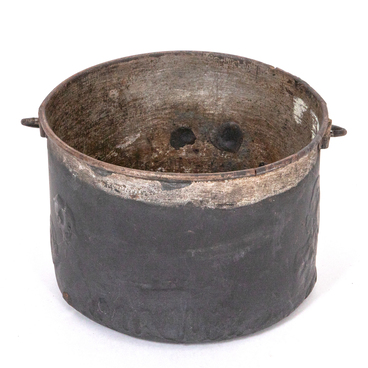The holster housed in the collection of the Museum Resource Center was made for a Tokarev pistol model 1933. This was the first domestically-made semi-automatic pistol adopted by the Workers’ and Peasants' Red Army (WPRA).
The TT pistol, or Tula Tokarev pristol, was developed by the Fedor Tokarev’s design team for a tender held in 1929. The army leadership set the task to replace Nagant revolvers and imported pistols with a domestic analog. The standard munition of the future weapon was prechosen — a 7.63 caliber cartridge with a 25 mm Mauser cartridge case. The pistol was specifically designed for this cartridge case.
In February 1931, the Revolutionary Military Council of the USSR ordered the first batch of new pistols (couple thousand pieces). Mass production of TT pistols began in 1933 at the Tula Arms Plant. By the beginning of the Great Patriotic War, more than 100 thousand pistols were produced per year. TT was used as a service weapon of the Armed Forces of the USSR up until the early 1960s and of law enforcement agencies until the mid-1970s. In 1952, the Makarov pistol was adopted, and the production of TT was stopped.
Several types of holsters (small leather cases) were developed for TT. A closed leather holster with a protective flap became a standard military holster. It was attached to the waist belt. The gun was placed vertically in it. The high-quality holster fixed the weapon in a certain position, holding it in place when the soldier was running or jumping. It was small and comfortable, dust and water resistant, and kept its shape for a long time.
Holsters were made of light leather for the Command Staff of the Red Army. They were worn on a waist belt or on a Sam Browne belt — a military leather belt specifically designed for carrying weapons. Unsophisticated holsters were made of brown leather. In wartime, kirza (a strong multi-layer textile fabric), tarp, or plastic plywood could be used, as well. The museum displays a holster made of brown leather.
Since 1942, the importance of holsters was reconsidered and it started to be attributed directly to weapons since it became clear that it is possible to use a pistol effectively only if it is stored in a high-quality and reliable holster. A professional holster reduces the number of manipulations with a weapon to four: a fighter can grab a pistol and simultaneously release it from the elements of equipment, take it out and remove the safety, choose the optimal arm position and send a cartridge into the chamber, point at the target and shoot.
The TT pistol, or Tula Tokarev pristol, was developed by the Fedor Tokarev’s design team for a tender held in 1929. The army leadership set the task to replace Nagant revolvers and imported pistols with a domestic analog. The standard munition of the future weapon was prechosen — a 7.63 caliber cartridge with a 25 mm Mauser cartridge case. The pistol was specifically designed for this cartridge case.
In February 1931, the Revolutionary Military Council of the USSR ordered the first batch of new pistols (couple thousand pieces). Mass production of TT pistols began in 1933 at the Tula Arms Plant. By the beginning of the Great Patriotic War, more than 100 thousand pistols were produced per year. TT was used as a service weapon of the Armed Forces of the USSR up until the early 1960s and of law enforcement agencies until the mid-1970s. In 1952, the Makarov pistol was adopted, and the production of TT was stopped.
Several types of holsters (small leather cases) were developed for TT. A closed leather holster with a protective flap became a standard military holster. It was attached to the waist belt. The gun was placed vertically in it. The high-quality holster fixed the weapon in a certain position, holding it in place when the soldier was running or jumping. It was small and comfortable, dust and water resistant, and kept its shape for a long time.
Holsters were made of light leather for the Command Staff of the Red Army. They were worn on a waist belt or on a Sam Browne belt — a military leather belt specifically designed for carrying weapons. Unsophisticated holsters were made of brown leather. In wartime, kirza (a strong multi-layer textile fabric), tarp, or plastic plywood could be used, as well. The museum displays a holster made of brown leather.
Since 1942, the importance of holsters was reconsidered and it started to be attributed directly to weapons since it became clear that it is possible to use a pistol effectively only if it is stored in a high-quality and reliable holster. A professional holster reduces the number of manipulations with a weapon to four: a fighter can grab a pistol and simultaneously release it from the elements of equipment, take it out and remove the safety, choose the optimal arm position and send a cartridge into the chamber, point at the target and shoot.



